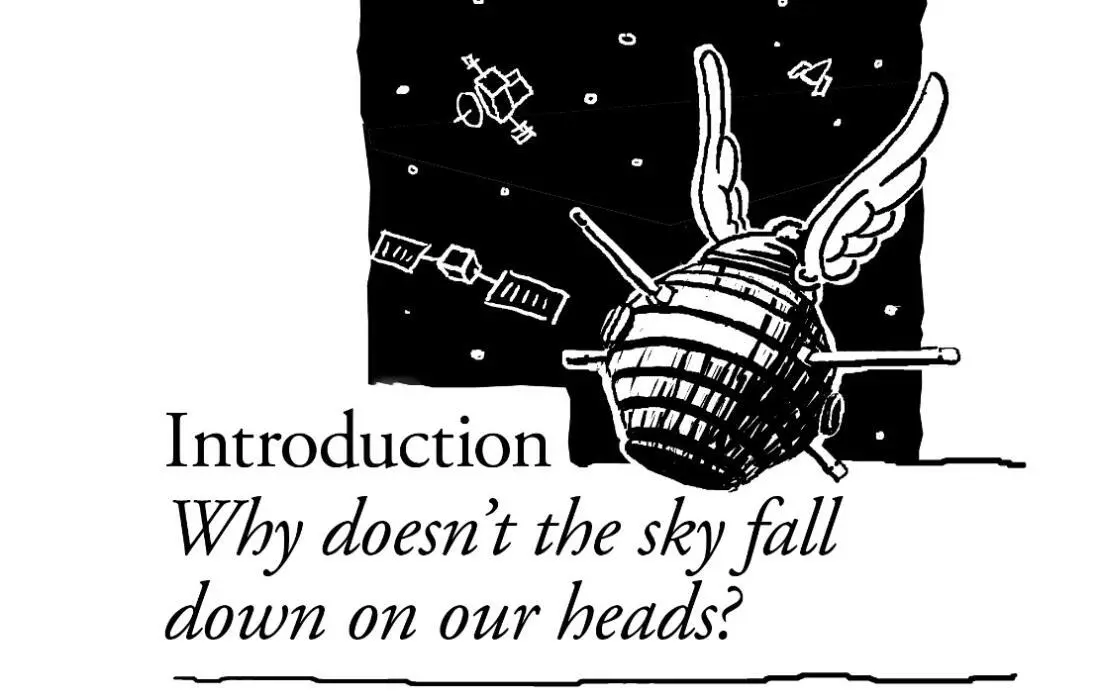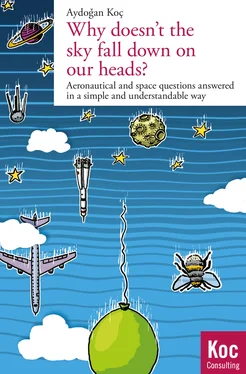Aydogan Koc
Why doesn’t the sky fall down on our heads?
Aeronautical and space questions answered in a simple and understandable way
Dieses ebook wurde erstellt bei

Inhaltsverzeichnis
Titel Aydogan Koc Why doesn’t the sky fall down on our heads? Aeronautical and space questions answered in a simple and understandable way Dieses ebook wurde erstellt bei
Preface
Introduction – Why doesn’t the sky fall down on our heads?
1. The History of Aviation
2. A Short History of Space Travel
3. Atmosphere
4. Aerodynamics
5. Flight mechanics
6. Flying plants and animals
7. Types of engines required for flying
8. Other types of flight vehicles
9. Helicopters
10. Aircraft
11. Space travel
Closure: Why does the apple fall on our head?
Impressum neobooks
Imprint
1. Edition, July 2019
Copyright © by Koc Consulting, Potsdam
www.koc-consulting.de
All rights reserved

Proofreading: Eugen Reichl
lllustrations: Stefan Schiessl
Layout: Exploredesign, Dachau
ISBN: 978-3-00-063289-1
Information about the author:
Aydogan Koc (1957) studied Aeronautical Engineering at the universities of Stuttgart and Darmstadt. He began his professional career as a Development Engineer for military aircraft in the advanced design office of Airbus Holding (formerly MBB/DASA/EADS). He then served as a senior manager in the space division. He also worked as the production manager with the “Eurofighter” consortium. Koc played an important role in development of the European aircraft program.
He realized important business developments, cooperation and international projects as a successful manager and entrepreneur in the aerospace industry during his professional career of over 19 years at Airbus and Eurofighter.
“Koc Consulting” was established by Aydoğan Koc in Munich in 2004 and in Ankara in 2006 to meet the demand for quality consulting in the world aerospace market. The company is an assertive company which realizes international defense, space and aircraft technology projects. It is one of the aims of Aydoğan Koc to draw upon many years of European engineering experience.
Aydogan Koc established an Sport and Trainer Aircraft Company at the Ankara Etimesgut Airport in December 2011 with the company name “THK Aircraft Company Inc.“ in partnership with the Turkish Aeronautical Association (THK, founded in 1925). He is also the General Manager and Deputy Chairman of the Advisory Board of the THK Aircraft Company.
He has a private pilot license and spends his leisure time with private flights.

Acknowledgement:
To my son Yiğit for his curiosity and interesting questions and everybody who showed support, interest and thus, contributed to the creation of this book on Aviation and Space.
I would also like to thank:
Mr. Nahit Ertongur for his generous technical consultancy
and support,
Mr. Eugen Reichl who published many popular articles on space,
and the Koc Consulting team.
This book is dedicated to our little friends, the
bumblebees which are masters of aerodynamics…
Today, considering the knowledge acquired by
mankind in Aerodynamics and Fluid Mechanics,
it stands as a fact that bumblebees cannot fly.
Luckily, they have not been told so until now!
These small and fat creatures continue to fly as
always without caring about the negative views.
My son used to ask me how aircraft fly and how giant rockets manage to get into space. While I was trying to give simple answers to these complicated questions, I realized we, as Aviation and Space engineers, never thought of simply explaining what is going on with aviation in a way to be understood by everyone. This reminded me of the fact that a too detailed knowledge about something can be a disadvantage at times: while trying to explain complicated things, one slowly gets caught up in details and starts to use many technical terms without realizing it and quickly loses the interest of their audience.
I started to give brief explanations, limit my answers to the essence and decorate it with anecdotes and examples to prevent my son from losing his focus. I continued to improve this method with time. You will find many questions that my son asked me and the summary of my answers in this book. This allows everybody to gain knowledge about aviation and space technology and related rules of physics without the need for special technical background.
Nothing can ever be too perfect to be improved. Please write to me if you have any suggestions to simplify the answers, interesting examples and clarifying short stories or maybe new questions. I hope you will contribute to the next edition with your questions.
E-Mail address: koc@koc-consulting.de
Introduction – Why doesn’t the sky fall down on our heads?

You know, almost all children (or those who are still children in their hearts) know Asterix the Gaul, his fat friend Obelix and the fierce and fearless village chief Vitalstatistix very well. He is known to fear neither the Romans nor the Vikings or other dangers in nature. He only has two problems: One of them is his wife, Impedimenta, and the other is the possibility of the sky falling on his head one day. As it is a known fact that men have no chance against women, we can consider the first problem as unsolvable and we can forget about it. But his second fear still exists, he is still anxious about the sky falling down on his head.
When we look at the open sky at night, everything is in order and beautiful harmony exists. All celestial bodies and planets move in the firmament the way they should, the Sun rises in the east and sets in the west, day after day!
That is why humans in the early days believed that the Earth is at the center of the universe. Only in recent centuries did people understand that the planet we live on is one of the eight known planets in our Solar system. These planets keep moving in their elliptical orbits at great distances around the giant Sun.
How insignificant and small our planet is can easily be demonstrated by a scaled model of the universe. Assuming 10 cm represents 1 million km; our Sun would be an orange 14 cm in diameter, looking like a yellowish lantern. Our world is the size of a grain of sand with a diameter of 1.3 mm circling the Sun at a distance of 15 m. The closest star to our Sun is the dwarf Proxima Centauri which is about the size of a cherry and is 4,000 km distance in our scale model. This equals the distance between Ağrı/Turkey and Madrid/Spain.
In our universe, every celestial body is on the move. Our world rotates around its own axis once a day, which is a speed of 1,670 km/h at the equator. Our satellite, the Moon, orbits the Earth in 29.5 days. This is an average orbital speed of 3,700 km/h. The average speed of our Earth orbiting around the Sun for a full circle in 365.25 days is 107,000 km/h. Our life source, the Sun, travels at about 1 million km/h around the center of our galaxy called The Milky Way.
Читать дальше
















